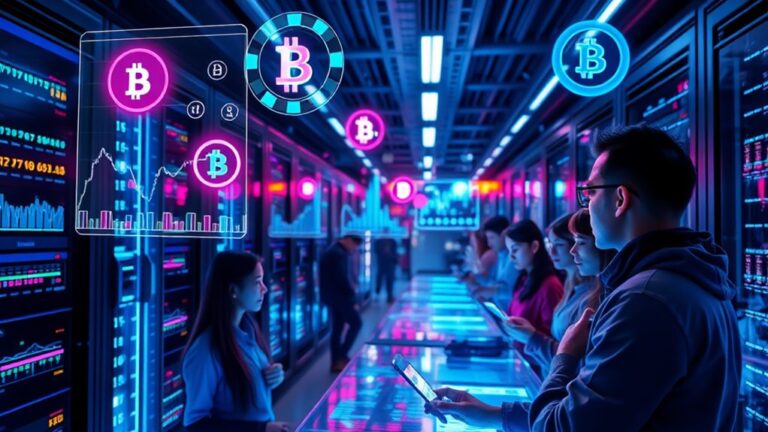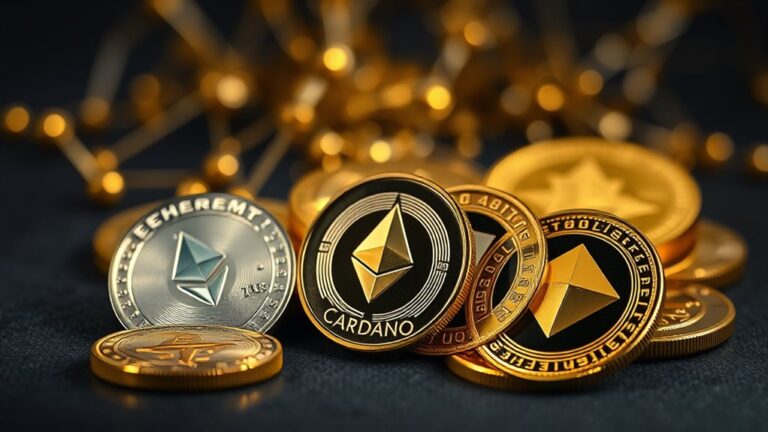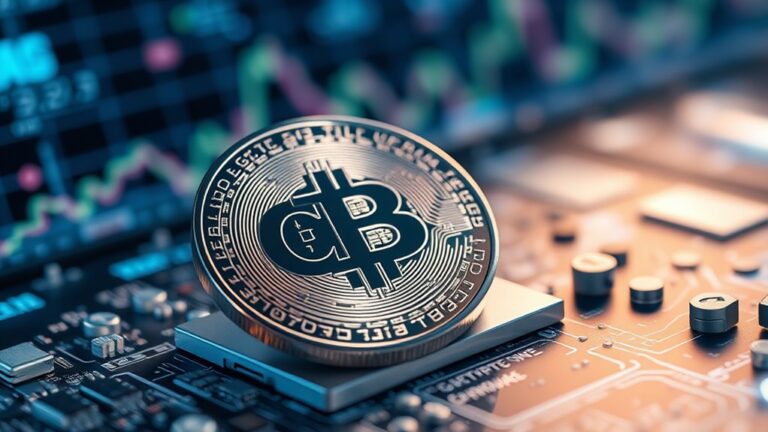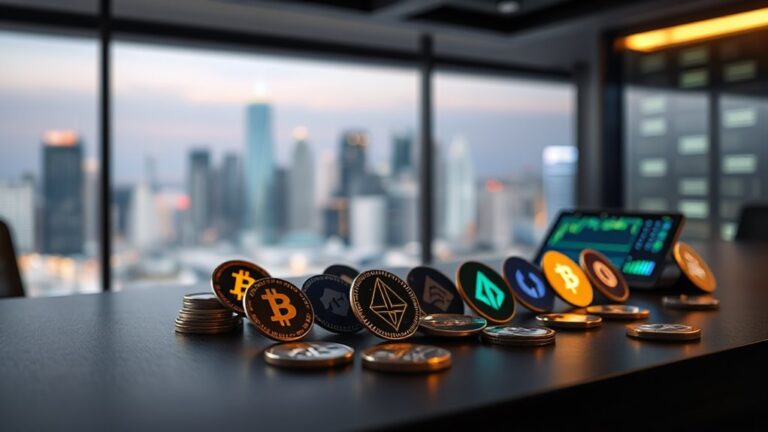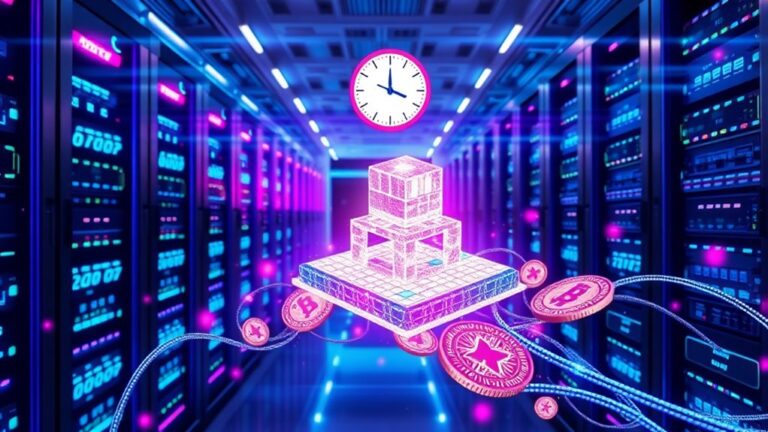
Top Gaming and Metaverse Tokens: Essential Picks for 2025
Top metaverse tokens for 2025 include Decentraland (MANA), The Sandbox (SAND), and Axie Infinity (AXS). These tokens support virtual land, game experiences, and digital asset trading. Render Token (RNDR) is also noted for facilitating decentralized rendering services. These offerings are enhanced by blockchain integration, providing transparency and security. As the market expands, fueled by technological innovations and increased digital asset demand, these tokens could see significant growth potential. Discover more insights into this evolving landscape.
Key Takeaways
- Render Token (RNDR): Valued at $1.91 billion, supports decentralized 3D rendering and critical for next-gen gaming experiences.
- The Sandbox (SAND): With a market cap of $819.01 million, empowers users to create and trade virtual experiences.
- Decentraland (MANA): Offers a $552.9 million market cap, facilitating virtual land and NFT transactions within immersive environments.
- Axie Infinity (AXS): At $579.2 million market cap, integral for play-to-earn mechanics and in-game activities.
- Floki Inu (FLOKI): Emerging token with a $764.22 million market cap, capturing attention for its potential in digital asset trading.
Manifold Utility and Integration in Metaverse Tokens
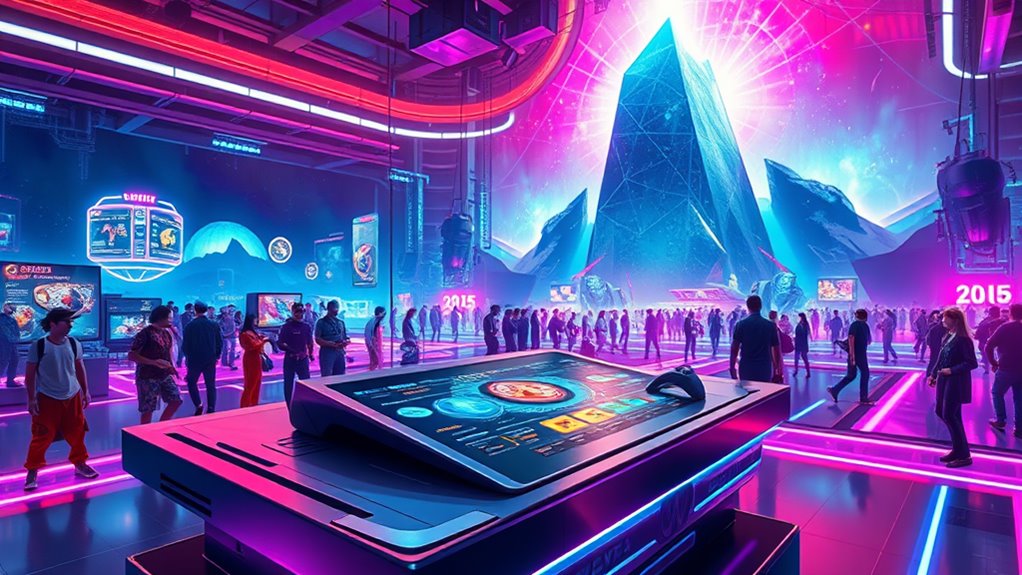
Manifold utility and integration in metaverse tokens highlight their essential roles in various virtual worlds. These tokens, such as MANA and SAND, streamline transactions in metaverses, allowing users to buy virtual goods, participate in events, and engage with decentralized markets.
Additionally, they facilitate NFT transactions, enabling users to trade unique digital assets. Governance and staking further empower token holders to influence platform decisions and earn passive income.
In terms of integration, these tokens leverage emerging technologies like blockchain for secure, transparent transactions and smart contracts for automation. Virtual reality enhances immersive experiences, intertwining with artificial intelligence to optimize creative tasks.
The ambition of interoperability seeks to unite different digital worlds, fostering a cohesive and expansive metaverse ecosystem. Moreover, blockchain technology enables digital ownership, supporting robust virtual economies and decentralized governance within these immersive virtual worlds.
Key Tokens by Market Cap
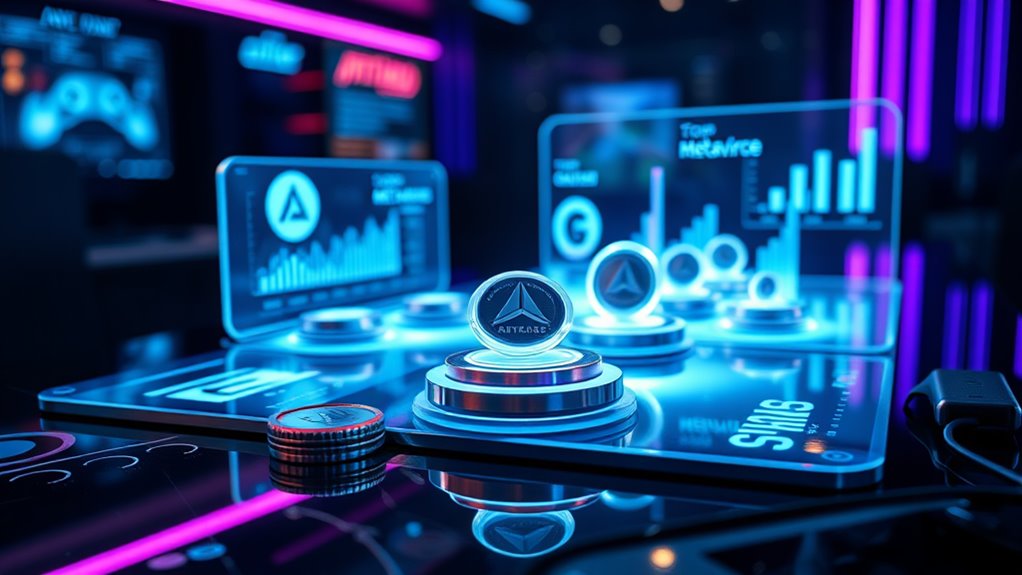
Key tokens by market cap offer a clear perspective on the current hierarchy within the metaverse and gaming token space.
Decentraland (MANA), The Sandbox (SAND), and Axie Infinity (AXS) are notable contenders, showcasing impressive market caps. MANA, valued at $552.9 million, is intrinsic for buying virtual land and NFTs, while SAND allows creation and trading of experiences within its $819.01 million scope. AXS, at $579.2 million, is pivotal for in-game activities.
Render Token (RNDR) leads with a $1.91 billion cap, supporting decentralized 3D rendering services. Floki Inu (FLOKI) also emerges with a $764.22 million mark.
Play-to-Earn Model Leaders
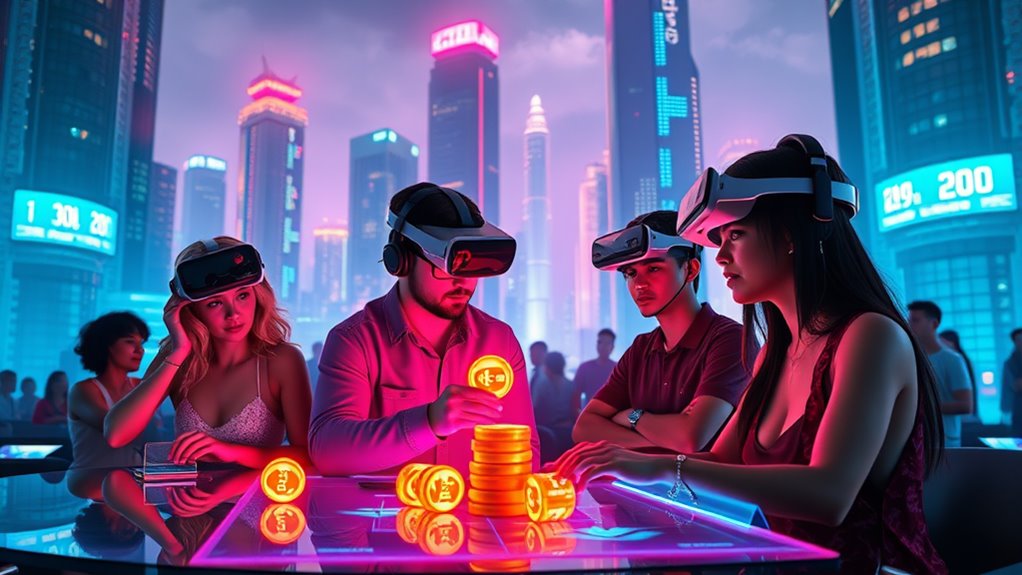
Among the various developments in the gaming industry, the Play-to-Earn (P2E) model has emerged as a significant trend, reflecting the growing fusion of gaming with blockchain technology.
The rising popularity of these games showcases increased demand as players are drawn to the potential of earning real money and cryptocurrencies. Leading games like Decentraland, Axie Infinity, and Gods Unchained exemplify innovation with mechanics such as NFT trading and staking, enriching the gaming experience and income possibilities.
Community engagement is essential for these games' success, driving development and ecosystem expansion. Blockchain advancements have improved game scalability and reduced transaction fees, supporting fluid P2E activities.
These efforts collectively emphasize a shift towards sustainable, profitable, and immersive gaming models. Moreover, the diversity within the crypto market, as seen with various categories of altcoins, provides opportunities for broader applications and innovation within the gaming sector.
Prominent ICOs and Presales in the Metaverse
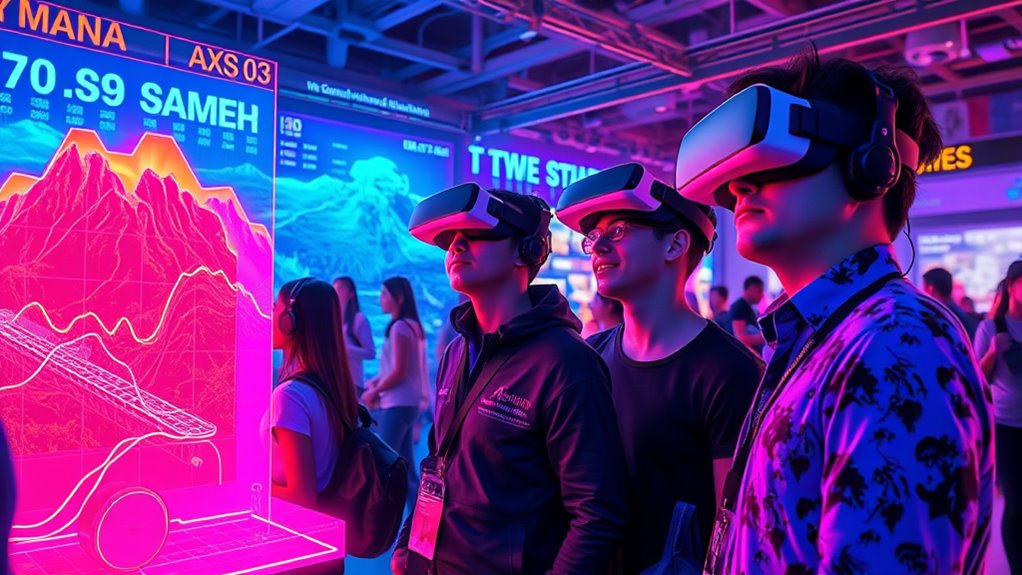
Initial Coin Offerings (ICOs) and presales have become pivotal for projects in the metaverse, offering an avenue for funding and early adoption. Among notable projects:
- Web3Bay (3BAY) positions itself to innovate e-commerce by tackling high transaction fees and privacy issues, raising significant funds in presales.
- GreenEnergyChain (GEC) focuses on ecological sustainability, tokenizing renewable projects to support green initiatives.
- MetaConnect (MTC) aims to enhance interoperability between different metaverse platforms, enabling smooth asset movement.
- AIChain (AIC) integrates artificial intelligence with blockchain to guarantee secure AI model exchanges, upholding data privacy.
The enthusiasm in metaverse ICOs is evident, though hurdles such as technological demands, interoperability challenges, and regulatory uncertainties remain.
Despite these obstacles, investors show strong interest, anticipating growth in the virtual world landscape.
Ecosystem Features Enhancing User Engagement

Immersive VR and AR technologies are greatly elevating user engagement within gaming ecosystems by creating dynamic environments where players interact in real-time.
These technologies enhance realism, making virtual worlds more enchanting, and when combined with NFT ownership, they offer players unique digital assets that can be monetized or traded.
Immersive VR/AR Experiences
Virtual and augmented reality technologies greatly enhance user experiences by integrating immersive elements into metaverse games, effectively simulating real-world interactions.
With advancements in hardware, such as improved AR/VR headsets developed by companies like Apple and Google, users experience enhanced interaction and accessibility. Immersion is further deepened by wearable technologies, such as haptic feedback gloves and suits, which simulate physical sensations in virtual environments.
The integration of AI-driven simulations offers lifelike environments for both training and entertainment purposes.
Key features of immersive VR/AR experiences include:
- Interactive 3D Environments: Users explore and socialize within vibrant 3D spaces.
- Customizable Avatars: Personalized digital representations enhance self-expression.
- Social Interactions: Real-time engagement fosters community.
- Digital Overlays: AR integrates digital elements with the real world.
NFT Ownership Benefits
While NFTs offer a revolutionary approach to digital ownership in gaming, they fundamentally alter how gamers interact with and perceive digital assets. By utilizing blockchain technology for decentralized control, players gain verified ownership, empowering them with authentic asset management across various games.
This asset portability enhances value, allowing NFTs to move seamlessly between platforms. Further, monetization opportunities enable players to convert their digital collectibles into real-world currency.
The interoperability of NFTs fosters an environment where digital items shift easily between virtual worlds, creating different avenues for engagement. Additionally, exclusive access to events and personalized avatars enhance social interactions, allowing NFT holders to build unique digital identities.
These features collectively contribute to a more immersive and engaging gaming ecosystem.
Future Growth and Market Projections

As the metaverse gaming market is projected to grow from $47.71 billion in 2024 to $67.96 billion by 2025, the expansion highlights substantial potential for related technologies.
Tokens like SAND, MANA, and AXS are poised for significant growth in their value, backed by the increasing integration of AR/VR and blockchain technologies.
Emerging projects within the metaverse space will likely benefit from this upward trajectory, driving innovation and expanding digital economies.
Metaverse Market Expansion
The metaverse market is poised for impressive growth in the coming years, with projections indicating a rapid expansion from $227.05 billion in 2024 to $316.34 billion in 2025, marking a compound annual growth rate (CAGR) of 39.3%.
This anticipated growth is driven by several factors:
- Technological Advancements: Innovations in VR and AR technologies are enhancing immersive experiences, which bolsters the metaverse's appeal.
- Increased Digital Asset Demand: The demand for NFTs and other digital assets is contributing to the market's expansion.
- Sector Impact: Significant impacts on entertainment, healthcare, and education exemplify the metaverse's broad influence.
- Investment Attraction: Economic opportunities have attracted sizable investments, paving the way for continued expansion.
As the market evolves, these elements will play an essential role in driving its growth.
Token Value Predictions
Token value predictions for gaming and metaverse tokens in 2025 indicate a landscape marked by potential growth and significant price volatility. Market vigilantes anticipate swings with the $GAME Token fluctuating between $0.5337 and $0.0009184, reflecting a high level of uncertainty. Similarly, Game Fantasy Token may oscillate from $2.07 to as low as $0.008123. The expected adoption of metaverse cryptocurrencies may drive growth; however, volatility remains a primary concern.
| Token | High Price 2025 | Low Price 2025 |
|---|---|---|
| $GAME Token | $0.5337 | $0.0009184 |
| Game Fantasy Token | $2.07 | $0.008123 |
Growth remains tied to blockchain adoption in gaming, potentially enhancing the value of these tokens. Yet the dynamics of market sentiment will heavily influence future stability.
Emerging Project Growth
While the metaverse continues to capture mainstream attention, emerging projects in the sector are poised for remarkable growth and innovation. Several drivers underpin this expansion.
- Increased Adoption: With giants like Meta and Microsoft investing heavily, mainstream adoption is accelerating, enhancing user engagement and recognition.
- Interoperability Focus: Platforms like Decentraland and The Sandbox are working on seamless connectivity between virtual worlds, enriching user experiences.
- Technological Advancements: The progression in AR, VR, and AI greatly enhances metaverse experiences by boosting realism and immersion.
- Play-to-Earn Models: Leaders such as Axie Infinity and Gala Games promote rewarding gameplay mechanics, drawing a larger player base.
The market's projected value, expected to approach $5 trillion by 2030, offers promising opportunities for emerging projects to capture user and investor interest.
Technological Innovations in Gaming Tokens
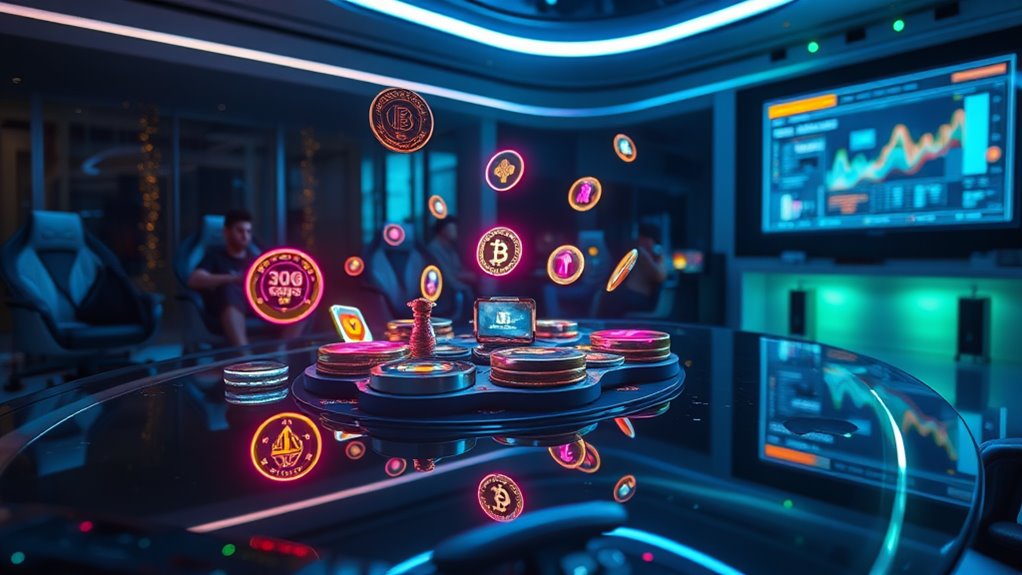
In numerous ways, technological innovations in gaming tokens are driving the evolution of the gaming industry. Advancements in blockchain technology such as decentralization and smart contracts enhance user control and transaction fairness, respectively. Scalability is improved through layer-2 solutions like Immutable X, while interoperability is facilitated by cross-chain bridges. VR and AR integration in metaverse gaming elevates user immersion, offering players enthralling experiences. Additionally, the rise of NFTs enables unique asset ownership and trading opportunities. Utility and adoption grow as tokens provide transactional benefits and governance options for users. Technological trends such as cloud gaming, AI, and enhanced graphics redefine gameplay realism and accessibility.
| Innovation | Benefit | Application |
|---|---|---|
| Decentralization | User asset control | In-game ownership |
| Smart Contracts | Fair transactions | NFT trades |
| Scalability | Improved experiences | Gaming platforms |
| Interoperability | Cross-chain transactions | Blockchain ecosystems |
| VR/AR Integration | Immersive gameplay | Metaverse games |
Security Enhancements in the Metaverse
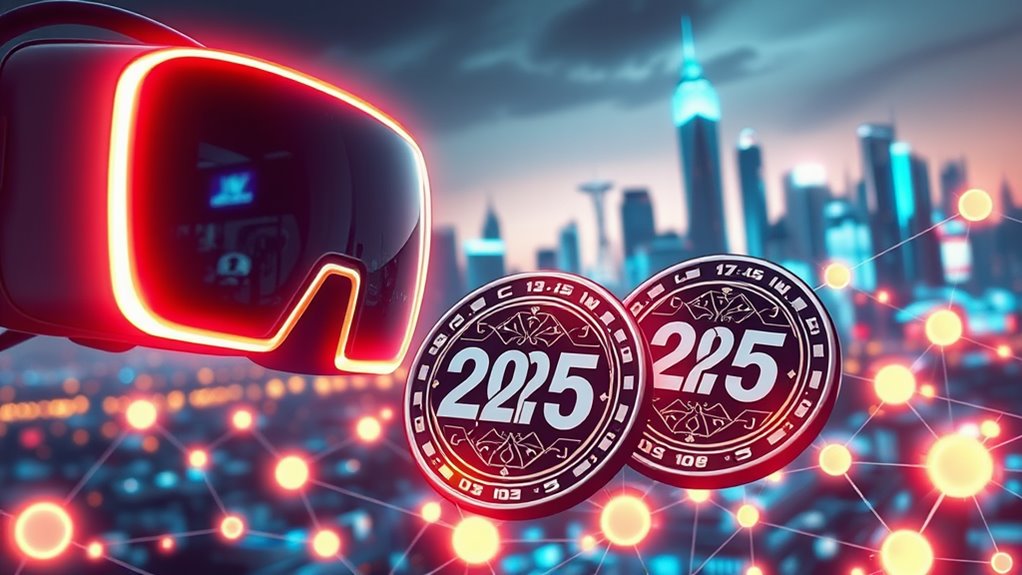
As the metaverse gains popularity, enhancing security becomes a paramount concern. Addressing these challenges involves several key strategies.
- Advanced Identity Verification: Techniques like biometric authentication and multi-factor authentication bolster security by preventing unauthorized access through stolen credentials.
- Blockchain and Smart Contracts: These technologies guarantee digital assets remain secure, offering decentralized control and tamper-proof transactions for users.
- AI-Powered Threat Detection: AI provides real-time monitoring and predictive analytics to anticipate and neutralize potential threats, minimizing risks before they escalate.
- User Education and Awareness: Promoting cybersecurity awareness through interactive training helps create informed communities, essential in identifying and mitigating threats effectively.
Implementing these measures aids in establishing a safer metaverse, protecting both virtual assets and personal information.
Frequently Asked Questions
What Differentiates Metaverse Tokens From Traditional Cryptocurrencies?
Metaverse tokens differ from traditional cryptocurrencies by emphasizing in-game utility, non-fungible token integration, and decentralized governance within virtual worlds. These tokens enhance digital interactions, ownership, and rewards, fostering a unique ecosystem beyond mere transactional purposes.
How Do Metaverse Tokens Impact Virtual Economies?
In the vast expanse of virtual worlds, metaverse tokens serve as the currency of empowerment, weaving digital ownership, seamless trades, and democratized governance into the fabric of sprawling virtual economies, revolutionizing transaction dynamics and fostering innovation.
Are There Risks Associated With Investing in Metaverse Tokens?
Investing in metaverse tokens presents substantial risks, including volatility, market fluctuations, and lack of regulation. Technical issues and economic instability further compound these challenges, alongside emerging regulatory and legal concerns, making strategic caution and thorough research critical for investors.
How Do Tokens Facilitate User Interactions in Virtual Worlds?
Tokens enable user interactions in virtual worlds by facilitating real-time socializing, enhancing gameplay with NFTs, and supporting virtual events. They allow content creators to be rewarded and foster collaboration, driving community building within metaverse environments.
What Role Do NFTS Play in Gaming Economies?
NFTs revolutionize gaming economies by granting players true ownership of in-game assets, fostering player-driven economies, enabling profit through play-to-earn models, and allowing potential asset use across different gaming platforms, though challenges persist.
Conclusion
To summarize, the gaming and metaverse token market is poised for significant growth by 2025, driven by evolving technologies and increased user engagement. Significantly, the market size for metaverse tokens is projected to reach $800 billion by that year. The combination of manifold utility, innovative play-to-earn models, and emerging security advancements underpins this dynamic landscape. As the metaverse continues to integrate more aspects of daily life, these tokens will likely play an essential role in shaping virtual economies and experiences.

